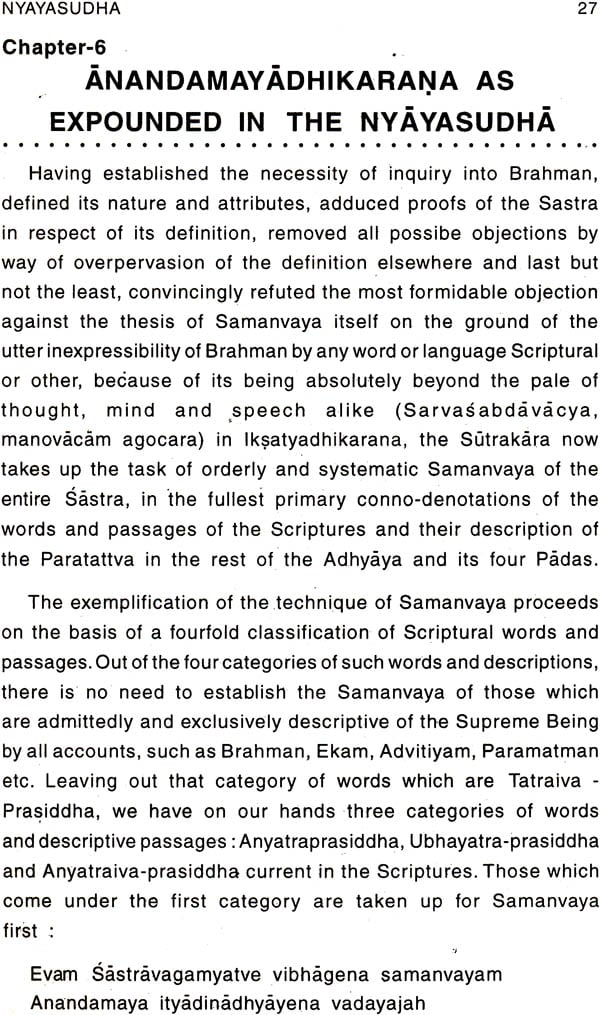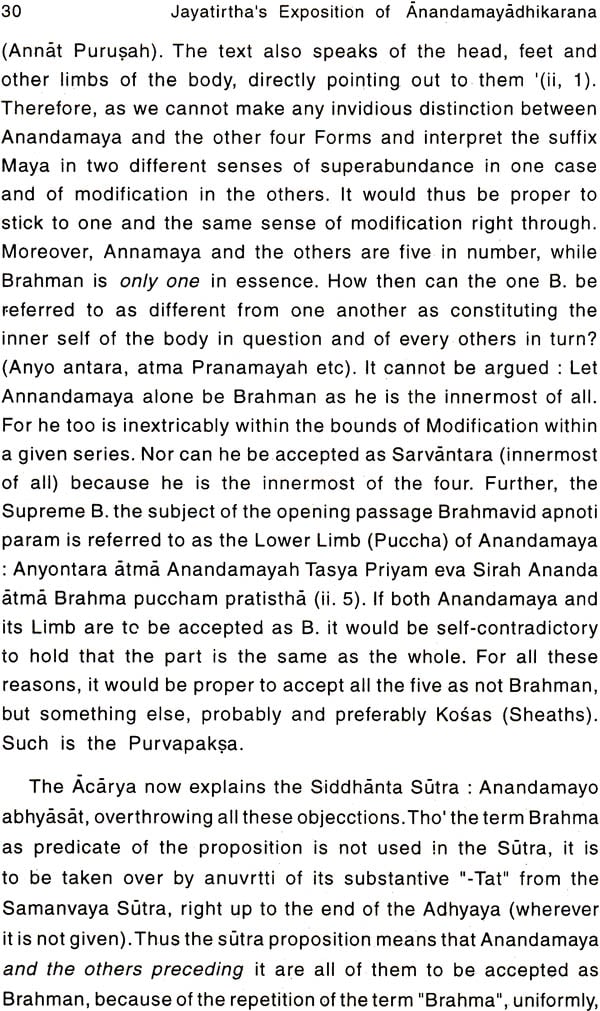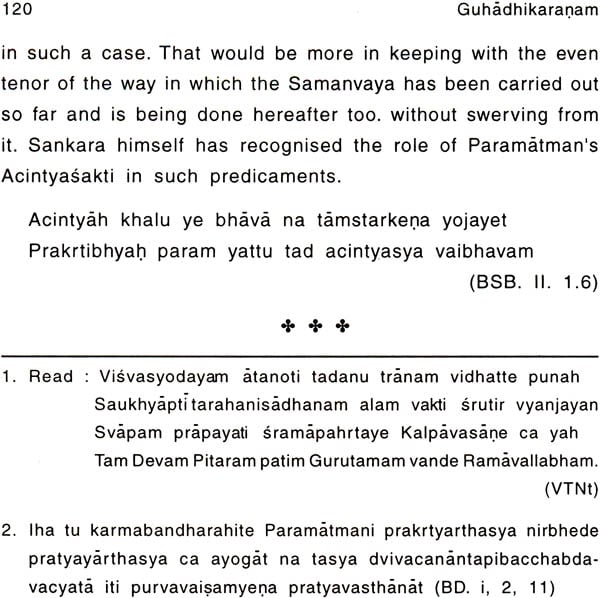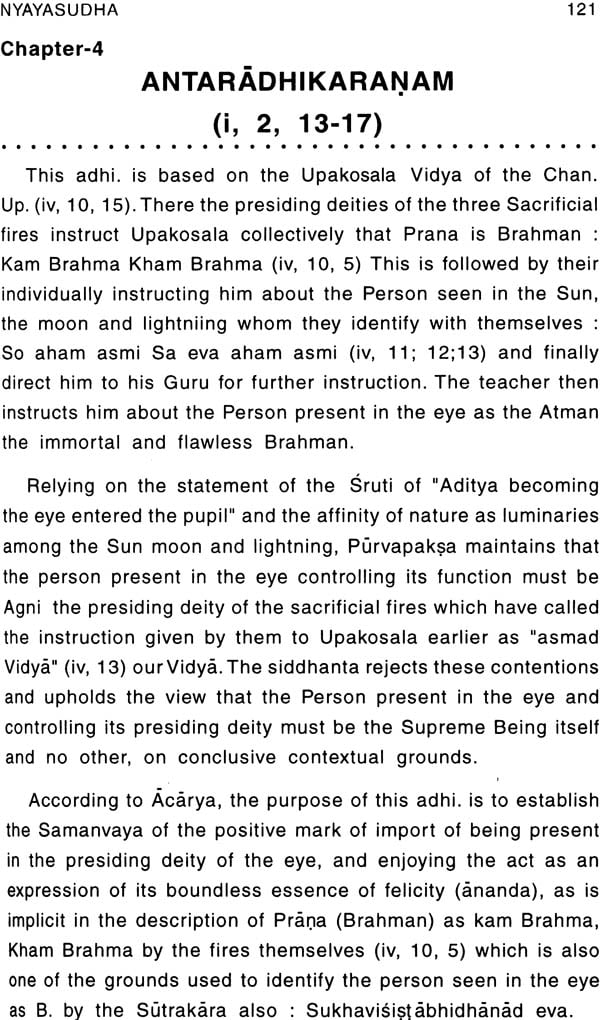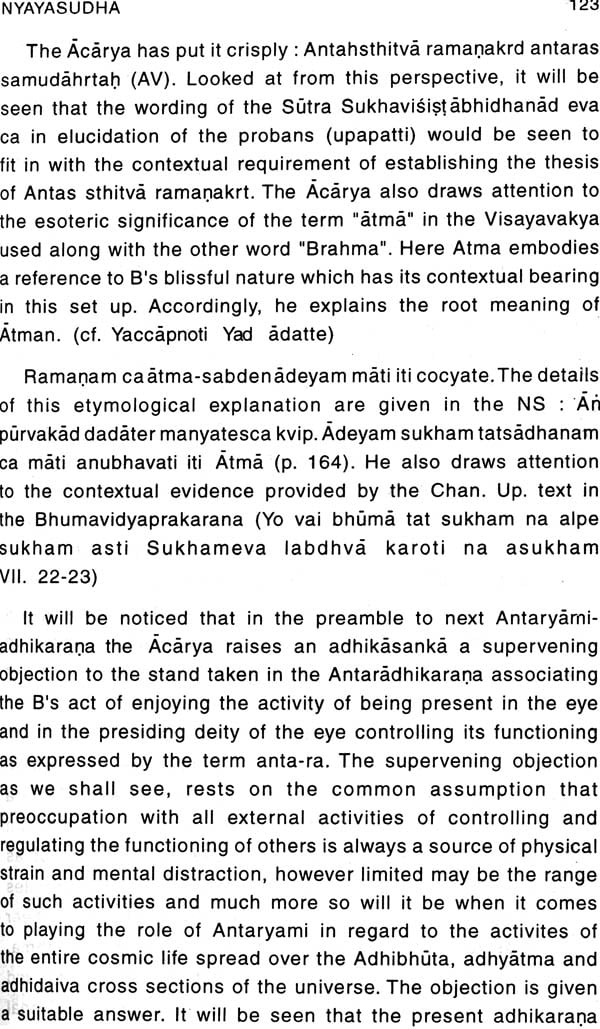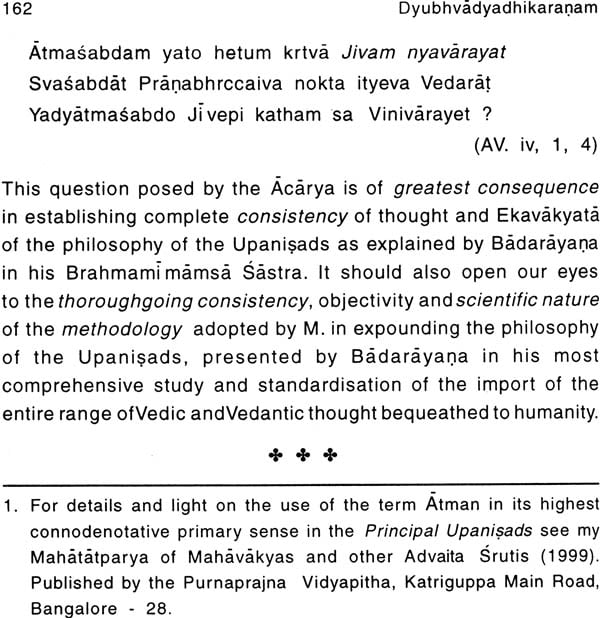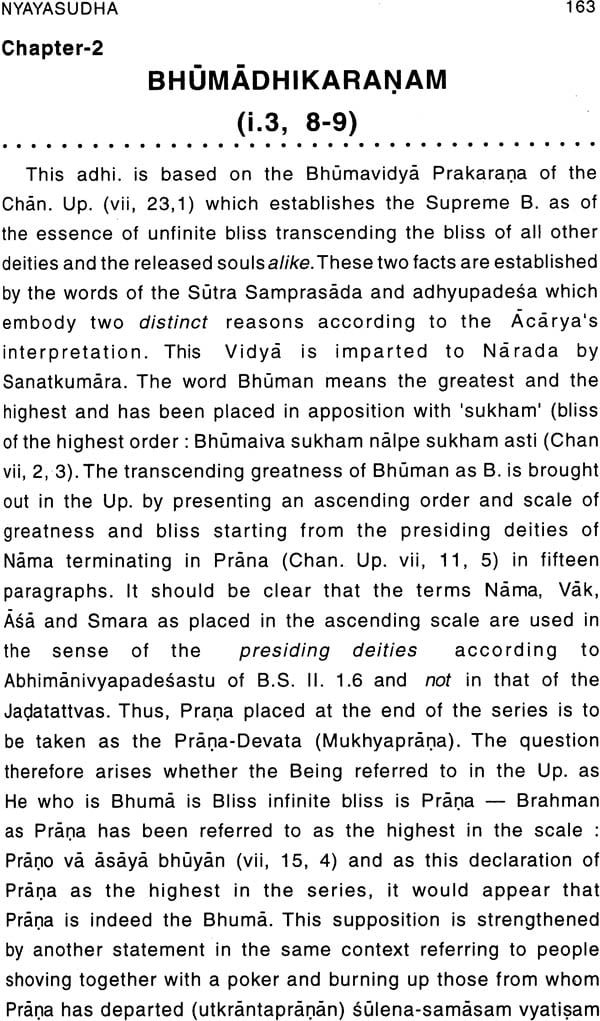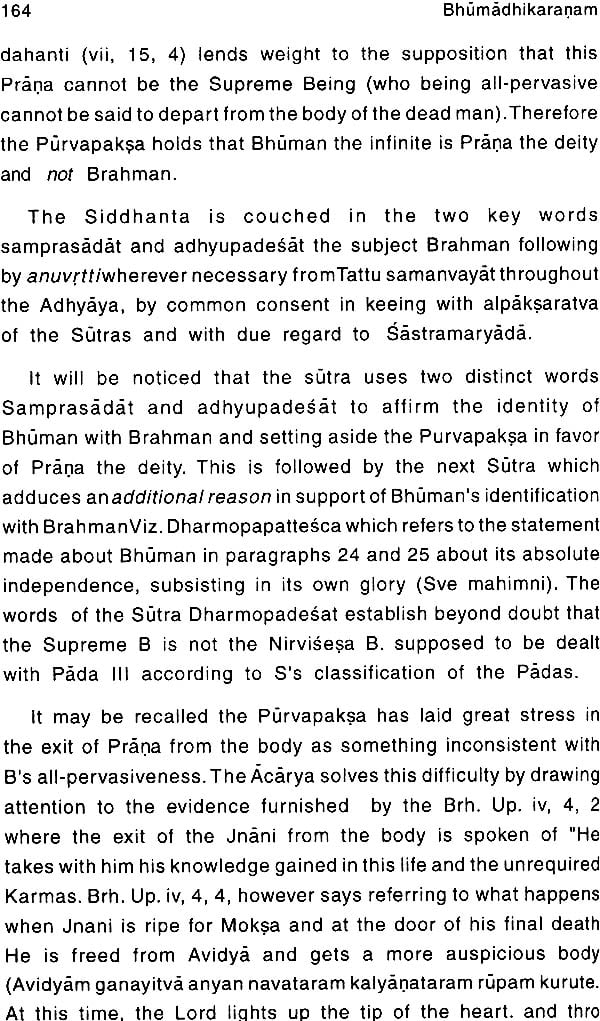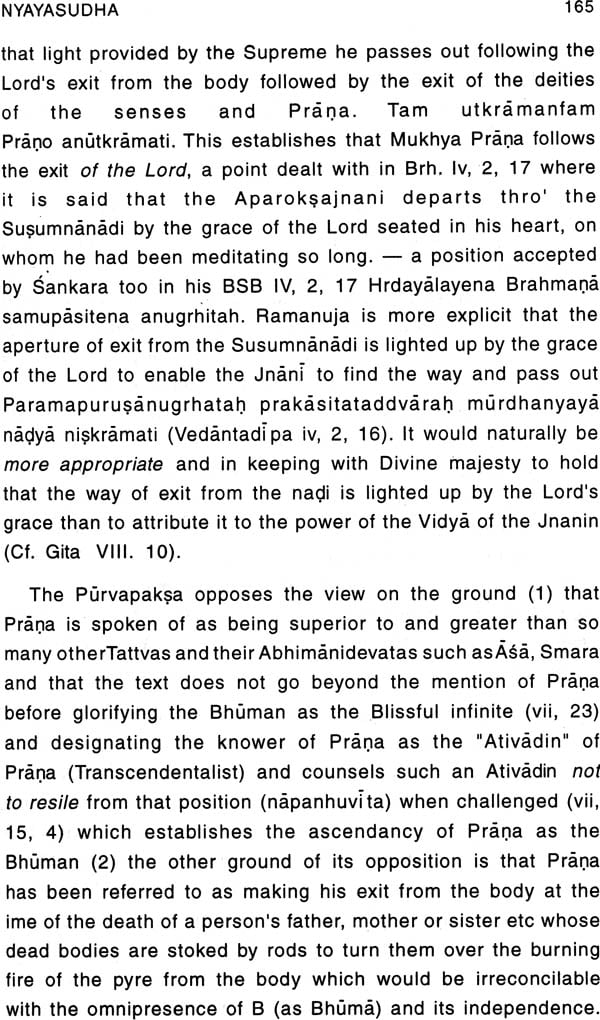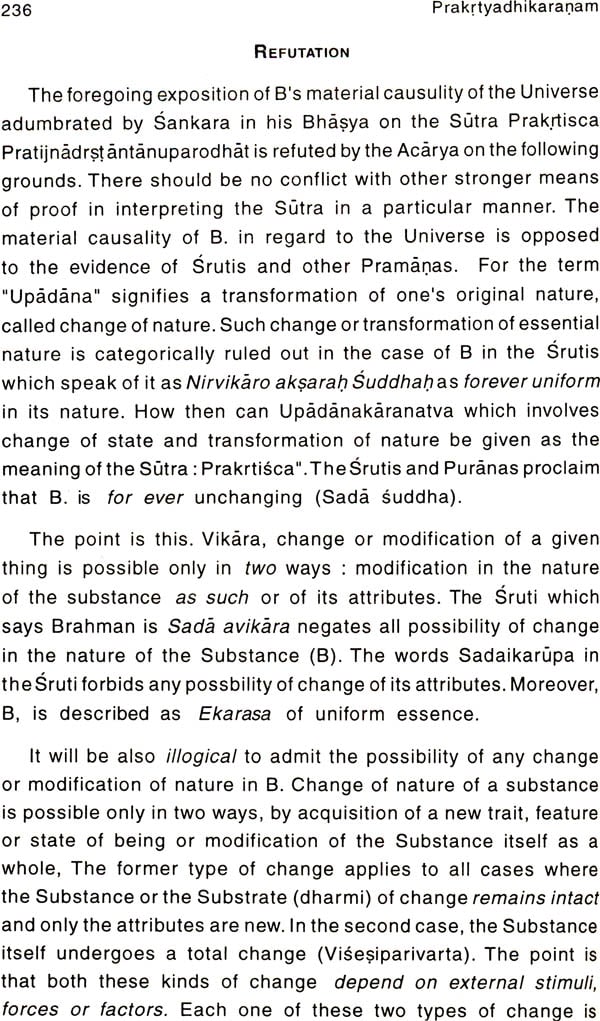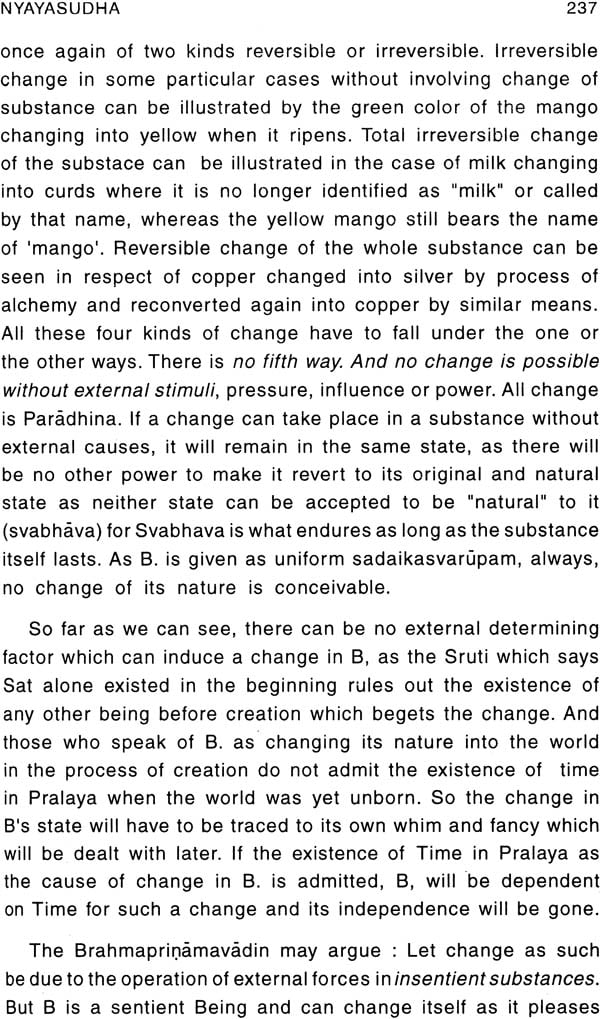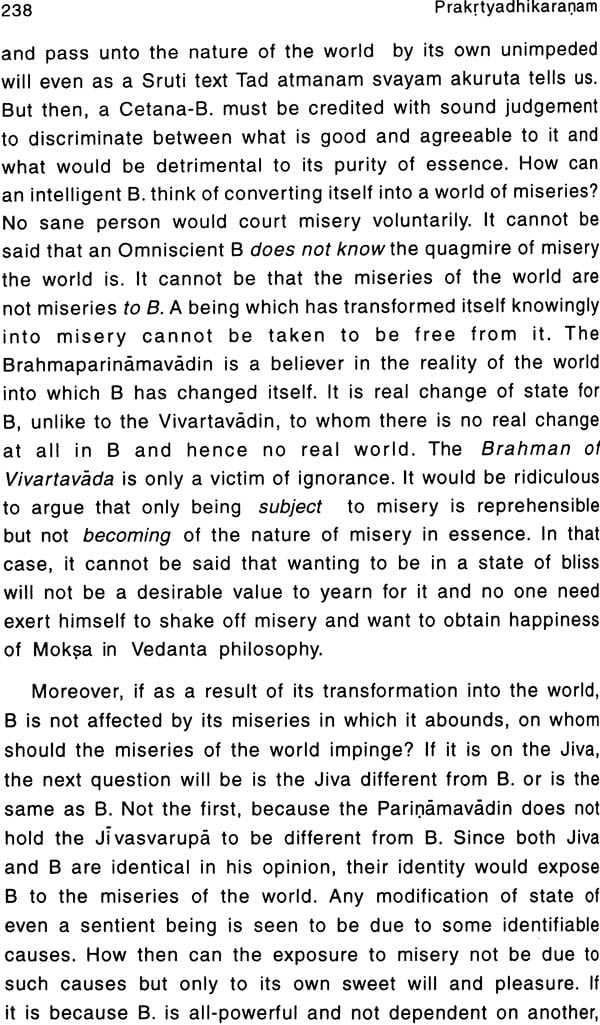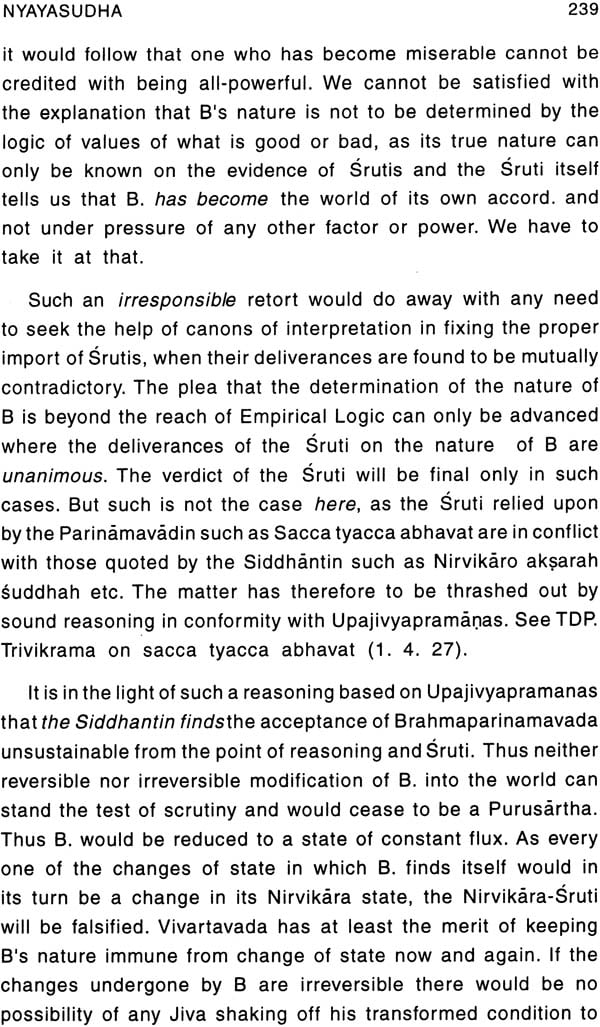
Nyaya Sudha of Sri Jayatirtha (First Adhyayas Complete) old and rare book
Book Specification
| Item Code: | NAN434 |
| Author: | Dr. B. N. K. Sharma |
| Publisher: | Vishwa Madhwa Maha Parishat, Bangalore |
| Language: | English |
| Edition: | 2000 |
| Pages: | 333 |
| Cover: | Paperback |
| Other Details | 8.5 inch x 5.5 inch |
| Weight | 390 gm |
Book Description
It is with great pleasure that I confront still another of Professor B.N.K. Sharma’s immensely valuable publications on Dvaita Vedanta. In tacking Jayatirtha’s mammoth Nyayasudha he has surely committed himself to another lifetime’s work. We are fortunate to have in the present Volume, a further extension of the penetrating analysis Professor Sharma brings to all his writings, of which there are vast number. (The list at the end of this volume hardly begins to amount to a proper bibliography of his writings. These are only a portion of the monographs; he has written a vast number of articles and other papers as well.) As those acquainted with the first part of the present translation will recognise. Prof. Sharma gives here much more than a translation. He has in fact provided what only a master teacher can provide, an in-depth analysis of the very heart of the work in all its considerable detail. He is a most lively master teacher as well-he not only elucidates the meaning of the text, but rebuts those who rush ahead without foundations on which to attempt their task (as his rebuttal of John Plott’s opinions illustrates).
Those of us who are devoting ourselves to preserving and disseminating the thought of classical Indian philosophers are much in B.N.K. Sharma’s debt, for it is he almost alone who has managed to explain the intricate analyses of Madhva and the Dvaita philosophers, so that we who do not easily read the original works can appreciate their profundity. We can only hope that Prof. Sharma is able to complete his monumental task.
This work is a continuation of the first part of my English rendering of the first five adhikaranas of the Nyayasudha of Jayatirtha (Pancadhikarani) published by the Raghvendra Ashram Mallesvaram, Bangalore in 1995. It begins with the Anandamayadhikarana of Adhyaya I and covers the text of the Nayasudha to the end of all the four Padas of the entire. I Adhyaya, called Samanvaya Adhyaya, The Nyayasudha is in the nature of an exposition of Acarya Madhva’s companion volume to his Bhasya on Brahmasutras. It is a highly condensed work in Verses and skips many adhikaranas of the B. Sutras. It supplements the Bhasya and reinforces his own interpretations, where necessary, with additional arguments explanation and textual criticism, covering the interpretations of the relevant sutras and adhikaranas as propounded in the Bhasyas of Sankara and occasionally of those of Bhaskara. Ramanuja and others. The A.V. is not routine explanatory work. It is a critical exhilarating exposition of both the Siddhanta and rival interpretations and is by and large problem-oriented. My work is a summary of the salient features of the Nyayasudha and its original, with necessary abridgement of both the expository and argumentative sides of the texts without loss continuity of thought.
Besides the Siddhanta interpretations of the Dvaita School and its criticisms of the interpretations of the Sutras and adhikaranas Sariras of the other schools, the N.S. discusses intensively many a problem of traditional Logic Epistemology and Metaphysics of other schools and exposes their weakess, upholding the siddhanta views in place of them. Here we find exhaustive, acute scholarly analytical discussions of the views of many great early thinkers of the Nyayavaisesika. The Sankhya, Mimamsa, Advaita and other schools. Its critical interest extends to the views of the grammatical schools and Alankara Sastras as well. The text of the N.S. runs to 24000 granthas (units of 32 syllables). It is a voluminous work of exhaustive thought content.
While adhering to the text of the N. S. I have thought it fit to enlarge its scope in respect of the scholarly discussions of the theory of the Brahmopadanavada and Brahmaparinama in their new oritentations, developed by and found in the works of Vallabha. Srikantha and other commentators on the B.S. and particularly the “Sphurtivada” of Janadeva, the philosopher –Saint of Maharashtra and a junior contemporary of Madhvacarya, developed by him in his famous Marathi work “Amrtanubhava”. Some modern scholars writing on Ramanuja’s conception of “Cit” and “Acit” (matter and jiva) as constituting the body of B in an inseparable relation (Aprthaksiddhi) have accused Madhva of over-emphasising B’s transcendence as against its immanence in Cit and Acit, in a body and soul relation. This charge against Madhva’ Philosophy has been advanced by Prof. John C. Plott in his “Philosophy of Devotion” (Motilal Banarsidass, Delhi, 1974, p. 72). He has insisted that the theory of immanence should be taken quite literally as a physical embodiment according to Ramanuja in the sense of a ‘unified relation’. He has therefore chargedMadhva of “completely” “evading” the aspect of immancee inRamanuja’s sense. “For Madhva, the transcendental nature of God is everything.” (p. 49). “He refuses to take the Sarira-idea literally but rather as an extension of Independence and still in the sense of transcendence of God, even in this all-pervasiveness” (p. 72).
I have brought to light for the first time that Ramanuja himself has literally admitted in his commentary on BS. I. 1.31 that one of the three types of Upasana of B. referred to in BS. I 1.31 consists in Upasana of B in its own intrinsic aspect: Paramatmana Eva Svakarena Upasana. Without its inseparable adjuncts of Cit and Acit (See P. 72).
This express statement of Ramanuja in his SriBhasya and in his Vedanta Di pa should be enough to show Prof. Plott that Ramanuja too, in the end, has to subscribe to the concept of B in its overall aspect of trascendence only. Otherwise Ramanuja's use of the term Svakarena meaning Upasana of B in its own intrinsic nature, apart from its being viewed as "Jiva-Sariraka and Pradhana Sariraka" would be untenable and will have to be given up. Prof. Plott should therefore give serious thought to this aspect of the matter and withdraw his charge against Madhva.
The readers will find in this present Vol. of the NS exhaustive and perspicacious discussions of many intricate problems of all Theistic philosophy in genera/and some with particular reference to Indian philosophy and Vedanta. They have all been sorted out and solved by the Acarya, in the best possibe manner.
The tantalising brevity of M's literary style both in prose and verse, has been more than made up for by the measured and graceful eloquenceof Jayatirtha by giving it, the necessary amplitude of utterance. Indeed, J's ability to see through the nooks and corners of M's mind is amazing in its clairvoyance, as can be seen from a close study of his commmentaries on M.
It gives me immense pleasure that Prof. Karl H. Potter of the Washington University, Seattle, has added a, new dimension to the work with his perspective Foreword for which I am very much indebted to him.
I owe my first inspiration to dedicate my life and career to an indepth study and research in Dvaita Vedanta and place their results before the modern academic forum, both national and international, so that they may, in course of time, form part of a Global Philosophy, which is in the offing, to my first meeting with H. H. Sri Satyadhyana Tirtha of the Uttaradi Mutt, the most revered, learned, dynamic and far-sighted of the Madhva Pithadhlpatis of his times. I met him in 1929 when I was doing my M. A. course in Sanskrit in the Presidency College, Chennai. I had approached him when he was camping in Tirupati, with a textual problem about the status of the slokas explanatory of the Mandukya Upanisad, about which there has been a protracted controversy in modern times between the Dvaita and Advaita Schools. The Svamiji confronted me with an off-hand quotation from S's Vivekacudamani, confirming the Dvaita view and urged me to make an intensive study of the entire literature of the Advaita, Visistadvaita and other schools to gather fuller evidence and report to him from time to time. I have done his bidding. The international community of Indologists is now seized of the results of many years of my Research work on the subject. The Svamiji did not live to see the final results of my Research work, as he passed away in 1942.
However, looking back at this distance of time, on the sum total of my published works till now. I feel satisfied that I have been able to fulfil the great expectations which the illustrious Svamiji had entertained of me.
I take it now, that the acceptance of this volume on N.S. by the Sri Uttaradi Mutt (Visva Madhva Mahaparisat) for publication, by the present Svamiji of the Mutt, fourth in succession from his illustrious predecessor, the young and enthusiastic Sri Satyatma Tirtha, the rising star in the firmament of the Dvaita school is proof enough that I have completely fulfilled the expectations of the venerable Satyadhyana Tirtha. The present Svamiji has also been gracious enough to bless this volume with a valuable Foreword in Sanskrit. I can only express my deepest sense of gratitude to him for his great act of kindness, affection and interest, by offering my humble prostrations at his holy feet.
I thank Sri R. Ananthan of Tirupur for his munificent personal contribution towards this publication and also record my appreciation of Sri /N. S. Chakrapani’s help in various ways.
I thank my son Dr. S. K. Bhavani, HOD of Sanskrit and Principal, K.J. Somaiya College of Arts & Commece, Mumbai-77 for all his untiring efforts in bringing out this edition in record time.
I also thank Shri Narayan Shetty and Shri Kiran Shetty of Navin Printers warmly for taking more than professional interest in bringing out this title very promptly and nicely.
The text of the Brahmasutras is divided into four well-knit Adhyayas, each with four quarters (Padas). Each Pada has its own governing thought (Padopadhi) falling under the scope of the main topic of the Adhyayas concerned. Each Pada is made up of a number of adhikaranas (topics) which varies according to exigencies.
Broadly speaking, the first Adhyaya is intended to establish the true nature and attributes of the supreme Brahman, the subject matter of the Brahma Mimamsa Sastra: Brahmasvarupanirnaya. The second stabilises the Sutrakara's findings about them by disposing of all possible objections based either on independent reasoning or the findings of other schools of thought opposed to Vedanta Darsana or seeming internal contradictions within the source marterials of the Sutras. The third Adhyaya is concerned with the means of realisation of such a Brahman thro' successive stages of Sadhanas of Vairagya, Bhakti, Upasana and direct vision (aparoksa). The last Adhyaya deals with Liberation (Moksa) after shedding all residual Karma, Utkranti thro; Devayana the mode of merger of the Devas, the route and the nature blessedness and enjoyment of the bliss of selfhood and communion with the Supreme.
The stage is now set for the actual demonstration of promised of the promised "Sam-anyaya", in its twin aspects of entirety of range of the source materials (Sastra) and primary connotation, in the rest of the first Adhyaya: Tam eva samanvayam prakatayati Anandamayo abhyasad ityadina samastena Adhyayena prayena (M. BSB. i, 1,12)
The unprovablility of the Advaitin's assumption of the utter inexpressibility of B. by any words of scripture (Avacya) and the total banishment of Jadaprakrti as the material cause of the universe, from the portals of the Sruti as Asabdam, have naturally led to Madhva's formulating a new scheme and technique of Samanvaya of Sastra in B. in the fullest and hightest primary sense of the words of scripture, without depriving the value and validity of the texts of the Karma and Devata Kandas or the existence and functioning of the Adhibhuta and other Tattvas of finite reality, in their respective spheres and milieu in their commonly accepted conventional primary senses, of the words of scripture.
As Advaita -B. is conceived as Nirvisesa and absolutely inexpressible by words, all talk of Samyak-Anvaya (Samanvaya) of Sastra in B. would be a mockery. To seek the help of Laksana Vritti for Samanvaya in a B. which is Nirvesesa would be a logical impossibility, as no Laksana can operate in respect of an entity which is absolutely inexpressible and unexpressed by any word whatsoever:
Sarva Sabda-avacyasya Laksana-ayukteh',
as Madhva rightly points out.
As Scriptures are a body of texts-a Sabdarasi, a three - fold classification of their statements to be exegetically correlated to B. into Anyatra, Ubhayatra and Anyatraiva prasiddha will be logically the most appropriate means of carrying out their Samanvaya in B., so emphatically postulated by the words of the 4th Sutra 'Tattu Samanvayat'.
The internal evidence of the first Adhyaya leaves no room for doubt that the range of survey is not limited to the ten or twelve Upanisads, but embraces the Pre-Upanisadic and Post Upanisadic source materials also. This is more strikingly seen in the third and fourth Adhyayas. Looking at the manner in which this exegetical correlation is carried out in a large number of adhikaranas, such as the Anandamaya, Akasa, Prana, Jyotis, Gayatri, Guham pravistau , Antaryami, Vaisvanara, Dyubhvadyayatana, Bhuma, Aksara, Avyakta, Pancajana and Prakrti, it is clear that the purpose of this Samanvaya is to secure the maximum extent and utmost range of referential integration of the entire thought-content of Scriptural passages with B., primarily and in the first place and only secondarily, in respect of the three categories of words, phrases and passages and their thought content of the source materials to other principles and Devatas of limited jurisdiction and other entities belonging to the realm of Aparatattvas (finite reality) which are also referred to there, in their ordinary conventionally accepted senses of those terms and descriptions. This dual way of Samanvaya calls for the adoption of a bifocal approach and a dual Vrtti (connodenotational reference) in terms of "Parama-mukhyavrtti" (highest reach of primary and plenary application of terms) and a simple conventional primary sense of the words in their worldly acceptance (Mukhyavrtti). The former partakes of the nature of the 'usage of the learned and the initiate" (Vidvad-rudht) and Mahayoga (intensive etymologisation). Since in the opinion of the Sutrakara not only human beings but the Devas too (celebrated in the Srutis are accepted as aspirants for Moksa thro' Brahman knowledge, (B. S. 1.3.26 -33) it is such intensive form of Samanvaya on the basis of vidvadrudhi and Mahayoga in the highest primary sense of words that is contemplated by the Sutrakara by making room at the same time for different levels of Adhikarins gods, risis and men to suit their calibre.
Pursuant to these objectives, words in the Scriptural texts chosen for Samanvaya referring to principles and entities are broadly classified under three heads of their wording 1) Anyatraprasiddha 2) Ubhayatraprasiddha and 3) Anyatraivaprasiddha. Others which are exclusively accepted as applicable only to the Supreme Being (Tatraivaprasiddha) do not call for any Samanvaya.
1) Anyatraprasiddha are those which while not generally found associated in the Scriptures with B. as their referent and are at the same time generally found associatied with principles or entities and beings other than Brahman, as for example Akasa, Jyoti, Anandamaya, Annamaya, etc.
2) Ubhyatraprasiddhas are those which are found applied in the Srutis and in worldly usage alike both to Brahman and other principles and entities (E.g. Aksara Vaisvanara)
3) Anyatraivaprasiddhas are those which prima facie cannot at all be referred to B. on account of insuperable obstacles of various kinds and are therefore usually found associated with things and principles other than B. in the Srutis themseves as for example Pancajana, Prakrti, Jiva etc.
These three types of words are again distinguished as Namatmakasabdas (substantives associated with some attribute (Gunisamanyavacaka) and appellatives associated with some distinctive mark of inference (Lingatmaka) e.g. Aditi Guham pravistau etc.
The first group of words is given precedence, because for purposes of Samanvaya in B. in the fullest primary sense, it would be sufficient to establish that much, leaving their association with other principles or entities undisturbed, as the Samanvaya contemplated is only in the highest primary sense of the terms. As the number of Padas in each Adhyaya is fixed at four, the Namatmaka and Lingatmakasabdas are dealt with separately only of the Anyatraprasiddha category. In the other Pada the Ubhayatraprasiddha Nama and Lingatmaka words are conjointly dealt with in one and the same Pada. As the Samanvaya of Anyatraivaprasiddha words offer special difficulties which call for special exegetical techniques of Samanvya in respect of the affliation of apellative basis of the terms (pravrttinimitta) of such terms in Brahman in their highest primary sense, they are taken up last.
It is such a systematic Samanvaya, in its twin senses of entirety of range of Scripture (kartsnyena) and in the fullest primary sense (Parama-mukhyavrtti) in principle, based on the usage of the initiate (vidvadrudhi) and intensive etymology (Mahayoga) indicated by the two senses of the prefix "Sam" - that is being carried out by the Sutrakara by way of illustration with typical instances rather than exhaustively, keeping in mind the different levels of aspirants like Devas Rsis and men. The saving feature of such a "Mahasamanvaya", as the Acarya calls it, is that it does not in any way affect or deprive the Karmakanda and the Mantra and Devata Kandas of the Vedic corpus of their basic values and validity and their distinctive status in their own milieu, notwithstanding their Samanvaya in B in their highest connodenotative application. The Grammar of Samanvya in the primary sense is explained in the Samakarsa adhikarana of the fourth Pada (i, 4, 16-22) from various angles. It will be appreciated that such bifocal approach to Samanvaya carried out by the Sutrakara (according to Madhva) takes us to the highest peaks of the philosophical thought-content of the Vedasastra as a whole as "Brahma-Vidya" par excellence, while at the same time preserving the identity and sanctity of the Karma and Devata Kandas at their fullest face value, without denigrating them in any way as relevant only to the transactions of an illusory world of "appearance" let loose by Avidya, to be liquidated by the knowledge of B.
| Dedication | v | |
| Abbreviations | ix | |
| Svamiji's Foreword | x | |
| Foreword by Prof. Karl H. Potter | xii | |
| Author's Preface | xiii | |
| Introduction | 1 | |
| Anandamayadhikarana in BS | 15 | |
| 6 | Jayatirtha's Exposition of Anandamayadhikarana | 27 |
| 7 | Antasthatva Adhikaranam | 54 |
| 8 | Akasadhikaranam | 60 |
| 9 | Pranadhikaranam | 65 |
| 10 | Jyotir Adhikaranam | 70 |
| 11 | Gayatri-Adhikaranam | 73 |
| 12 | 78 | |
| 1 | Sarvatra Prasiddha Adhikaranam | 99 |
| 2 | Attradhikaranam | 107 |
| 3 | Guhadhikaranam | 113 |
| 4 | Antara-Adhikaranam | 121 |
| 5 | Antaryami Adhikaranam | 127 |
| 6 | Adrsyatva Adhikaranam | 133 |
| 7 | Vaisvanara Adhikaranam | 151 |
| 1 | Dyubhvadyadhikaranam | 157 |
| 2 | Bhumadhikaranam | 163 |
| 3 | Aksaradhikaranam | 173 |
| 1 | Anumanika Adhikaranam | 181 |
| 2 | Jyotirupakramattvadhikaranam | 207 |
| 3 | Prakrtyadhikaranam | 229 |
| Appendix-I | Review of Concept of Liberation in Madhva-Vedanta' by Prof. Ashok Kumar Lad, Dept. Of Philosophy, TRS College, REWA (M.P.) 1967 | 298 |
| Appendix-II | Sri Satyadhyana Tirtha | 306 |
| Appendix-III | Other Published works of the author | 308 |
| Index | 310 |
